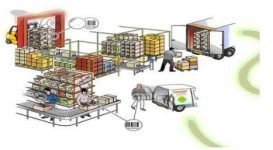
The medical logistics industry joint application of RFID and two-dimensional bar code system solutions
[ad_1]
1 Introduction
Pharmaceutical logistics tracking is the application of information tracking technology to realize the complete process of information collection and transmission in the logistics links of production, warehousing, transportation, processing, and distribution of pharmaceutical products, and to obtain logistics information. It mainly includes the two basic functions of full drug information tracking and post-information traceability, and provides important logistics information for relevant decision-makers to make decisions.

Figure Demonstration diagram of the application of barcode in the pharmaceutical logistics industry
At present, common logistics tracking systems are used in logistics operations in fixed locations such as factories, warehouses, distribution centers, etc., using barcodes to identify items, and relying on database to record item status information to track items; in the transportation process of items, GPS receivers are used to identify Vehicles, with carriages as transport units, track items by tracking vehicles. With the development of automatic identification technologies such as bar code and radio frequency identification (RFID), there has been an application model that uses RFID to track a single item alone, as well as the combined application of bar code and RFID technology. This article discusses how to jointly apply two-dimensional bar code and RFID technology in the medical logistics tracking system.
2 The status quo of the combined application of two-dimensional bar code and RFID in logistics tracking
RFID reads information through radio, and has the characteristics of non-contact, simultaneous reading of multiple objects, large information capacity, long communication distance, fast reading speed, and strong environmental adaptability. Compared with one-dimensional barcodes, two-dimensional barcodes do not need database support, store and identify information independently, and have the advantages of large information capacity and high reliability. Two-dimensional barcodes need to be read by optical scanning, and the reading efficiency is much lower than that of RF ID. However, two-dimensional barcodes have more advantages in application cost. Its application cost is only in the barcode label itself, while the cost of RFID tags is still relatively high.
Due to the high application cost of RFID technology and the inconsistent communication standards, it is difficult to completely solve the problems. , Food safety and other industries have achieved good application effects in logistics. In the field of military logistics, Chen Xinggang and others also proposed the joint application of two-dimensional bar code and RFID technology to the management of warehousing materials, the tracking of in-transit materials, and the remote allocation to help realize the visualization of military logistics.
3 Discussion on joint application in medical logistics tracking system
Different from general logistics, medical logistics is characterized by high commodity value, strong circulation timeliness, and strict regulation and supervision. Therefore, the joint application of two-dimensional bar code and RFID technology in the pharmaceutical logistics tracking system cannot be a mechanical method of other industry logistics. It needs to combine the characteristics of pharmaceutical logistics, follow the relevant laws and regulations of the pharmaceutical industry, and explore new application models.
3. 1 Uniform drug coding and labeling methods are the foundation
3. 1. 1 Uniformity of unique drug identification codes
To realize the whole logistics tracking of medicines, firstly, the medicines to be tracked need to be uniquely coded and identified. Although the SFDA recently promulgated the national drug coding rules, the industry has not unified the derivative application standards of drug coding in a timely manner based on this. Based on the national drug coding rules, we propose a coding scheme that uniquely identifies drugs. The code is composed of three parts: a 14-bit native code, a 16-bit serial code and a 2-bit check code, and the code length is 32 bits. This bit code refers to the 14-digit “National Drug Code Standard Code” stipulated by SFDA, which is used to identify specific types of drugs. The serial code is composed of the production batch number and the product sequence number, and is used to identify the production sequence of the medicine. The check code is calculated and generated according to the local code and the sequence code, which can identify the authenticity of the code. A set of codes uniquely identifies a box (bottle) of medicines.
3. 1. 2 Two-dimensional bar code-used for the identification of pharmaceutical retail packaging
At present, it has become the development trend of the pharmaceutical industry to use the smallest retail packaging of medicines as the basic identification unit for coding and marking. The drug manufacturer is responsible for printing and labeling two-dimensional bar code labels for each box of drugs. The label consists of two parts: the bar code graphic area and the character display area. Important drug attribute information such as drug name, specification, manufacturer, production batch number, expiration date, unique identification code, etc., needs to be printed in the display area in characters so that logistics operators can check the information after scanning the barcode. If it is a special medicine, it should print a striking classification label according to the regulations. In addition to containing the information in the display area, the bar code graphic area can also record the pharmacological classification, storage conditions, and guide prices of drugs, which is convenient for dealers to enter drug information.
[ad_2]



